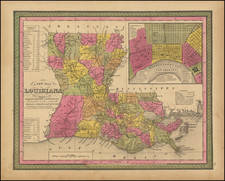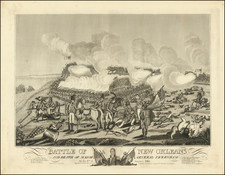New Orleans Before The Great Fire of 1788
Jacques Nicolas Bellin's important early map of New Orleans, first issued in Xavier Charlevoix's Histoire de la Nouvelle France. This is one of the few surviving printed plans of the City that pre-date the Great Fire.
The present example is the second state of the map. The first state is distinguishable from subsequent states by the inclusion of the date, the position of the title of the map and the note in the lower right corner that the map was engraved by Dheulland.
New Orleans was founded in 1718 by the French Mississippi Company under the leadership of Jean-Baptiste Le Moyne de Bienville. By the mid-century, it had grown from a fledgling settlement into a bustling colonial port. New Orleans was distinctive in its layout. The city was meticulously planned with a grid system, a rarity for settlements of that time. The centerpiece, Place d’Armes (now known as Jackson Square), was a spacious public square that would see countless military parades, markets, and public gatherings. This square was emblematic of the city's multifaceted role as both a military bastion and a hub of trade.
The French influence was pervasive in New Orleans. From its architecture, with wrought iron balconies and walled courtyards, to its religion, where the Catholic Church played a dominant role, French roots were evident. The Ursuline nuns, for instance, established one of North America’s first Catholic schools for girls, and the Capuchins were central to religious activities in the city.
However, the mid-18th century also brought about significant change. The Treaty of Paris in 1763 marked the end of the French and Indian War, and France ceded Louisiana to Spain. Under Spanish rule, the city underwent transformations, including infrastructural advancements like the construction of brick buildings which replaced the more flammable wooden structures, a change influenced by the Great New Orleans Fire of 1788.
The map includes the earliest obtainable plan of New Orleans, complete with a key naming 18 placenames. The plan names the streets and well over 100 buildings are shown. The list of places shown includes:
- a. Parish Church served by the Capuchins: St. Louis Cathedral, the oldest cathedral in the U.S., stands in its place now.
- b. Place d’Armes: Now known as Jackson Square; originally designed as the military parade ground and open market.
- c. Couvent des Capucins: Convent of New Orleans' Capuchin monks
- d. Prisons:
- e. Corps de Garde: Military installations found in various parts of the city.
- f. Gouvernement: Colonial government buildings.
- g. Intendance: Headquarters of the Intendant, the central governing figure in the French colonial administrative structure.
- h. Hôpital: Hospital
- i. Ursulines: The Ursuline nuns established a convent and school which was vital for the city's educational and medical needs.
- k. Magasins du Roi: Warehouses where goods owned by the French Government.
- l. Cazernes: Military barracks.
- m. Forges du Roi: Royal forges or blacksmith shops.
- n. Moulin à vent et à Cheval: Mills powered by wind or horse.
- o. Hangar de la Marine: Shipyards
- p. Corps de Garde des Bourgeois: Guardhouse
- q. Cabanes des Nègres: Huts of the enslaved black residents who managed the Mill
- r. Poudrière: Storage facility for gunpowder.
- s. Nouvelle Maison des Ursulines: Newer Ursuline nuns structure
Jacques-Nicolas Bellin (1703-1772) was among the most important mapmakers of the eighteenth century. In 1721, at only the age of 18, he was appointed Hydrographer to the French Navy. In August 1741, he became the first Ingénieur de la Marine of the Dépôt des cartes et plans de la Marine (the French Hydrographic Office) and was named Official Hydrographer of the French King.
During his term as Official Hydrographer, the Dépôt was the one of the most active centers for the production of sea charts and maps in Europe. Their output included a folio-format sea atlas of France, the Neptune Francois. He also produced a number of sea atlases of the world, including the Atlas Maritime and the Hydrographie Francaise. These gained fame and distinction all over Europe and were republished throughout the eighteenth and even in the nineteenth century.
Bellin also produced smaller format maps such as the 1764 Petit Atlas Maritime, containing 580 finely-detailed charts. He also contributed a number of maps for the 15-volume Histoire Generale des Voyages of Antoine François Prévost.
Bellin set a very high standard of workmanship and accuracy, cementing France's leading role in European cartography and geography during this period. Many of his maps were copied by other mapmakers across the continent.









![[ New Orleans ] Grondvlakte van Nieuw Orleans, de Hoofdstad van Louisiana [with] De Uitloop vande Rivier Missisippi [and] De Oostelyke ingang van de Missisippi met cen Plan van het Fort . . .](https://storage.googleapis.com/raremaps/img/small/93086.jpg)
![[ New Orleans, Louisiana / Southern Travel Letter ] Lyman Adams letter to Austin Adams, December 21, 1839](https://storage.googleapis.com/raremaps/img/small/96629.jpg)


![[ St. Henry's Church, New Orleans and Mission ] La Mission de St. Henri, Diocese de la Nouvelle-Orleans (Etats-Unis)](https://storage.googleapis.com/raremaps/img/small/99740.jpg)
![Colton's The City of Louisville [with] Colton's The City of New Orleans](https://storage.googleapis.com/raremaps/img/small/100352.jpg)